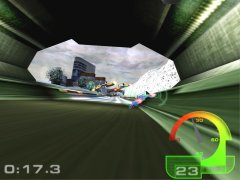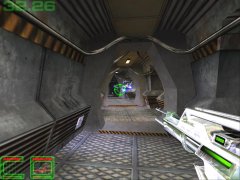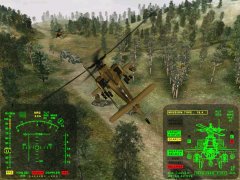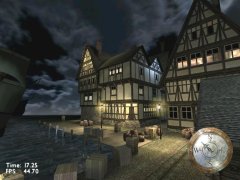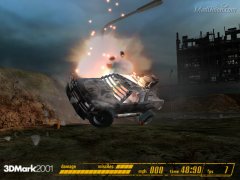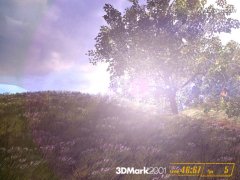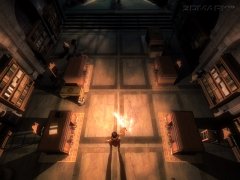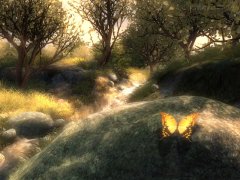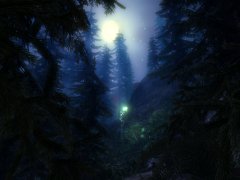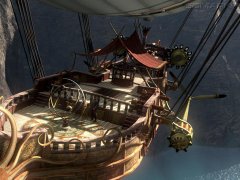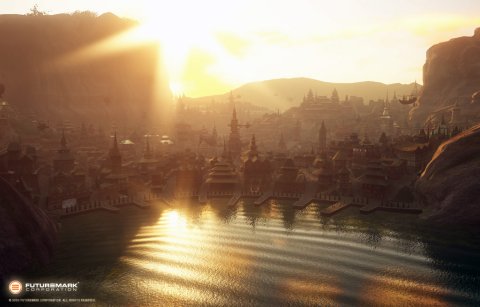The following collection of images and scene descriptions highlight the various changes that Futuremark have implemented in the 3DMark over the years and the technologies they've employed. All images and details were gratefully supplied by Futuremark.
3DMark99 Futuremark launched their first version of 3DMark in October 1998, later updated to 3DMark99 MAX in the following year:
|
|
|
| Game Test 1 - The Race -
DirectX 6 features used. -
16-bit colour, 16-bit depth and 16-bit textures. -
Single textures per surface; single pass render. -
Alpha blending (additive and multiplicative) used. -
Bilinear/trilinear texture filtering. -
Vertex fog. -
Up to 19 thousand polygons and 16 thousand vertices per frame; approximately 3MB of textures per frame.
| Game Test 2 - First Person -
DirectX 6 features used. -
16-bit colour, 16-bit depth and 16-bit textures. -
Diffuse gouraud lighting used. -
Two textures per surface applied via multitexturing or two pass rendering. -
Alpha blending (additive and multiplicative) used. -
Bilinear/trilinear texture filtering. -
Vertex fog. -
Up to 20 thousand polygons and 19 thousand vertices per frame; approximately 5MB of textures per frame.
|
3DMark2000
To meet the new functions offered in DirectX 7, Futuremark (then MadOnion) produced 3DMark2000:
|
|
|
|
| Game Test 1 - Helicopter - DirectX 7 Hardware TnL pipeline.
- 16-bit colour, 16-bit depth and 16-bit textures (adjustable to 32-bit).
- Triple buffering and bilinear filtering.
- Up to 5 lights per scene, with falloff ranges.
-
Up to 53 thousand polygons, 71 thousand vertices and 3MB of textures per frame. | Game Test 2 - Adventure - DirectX 7 Hardware TnL pipeline.
- 16-bit colour, 16-bit depth and 16-bit textures (adjustable to 32-bit).
- Triple buffering and bilinear filtering.
- Characters and objects have geometry LOD.
- Characters are skinned.
- Up to 8 lights per scene, with falloff ranges.
- Up to 30 thousand polygons, 37 thousand vertices and 3.4MB of textures per frame.
|
3DMark2001
Futuremark (then MadOnion) offered a benchmark for DirectX 8 hardware in March 2001:
|
|
|
|
| Game Test 1 - Car Chase - DirectX 8 Pure hardware pipeline.
- Between one and three texture layers are applied to each surface, object and model.
- Non-static models cast render-to-texture shadows that are transformed via vertex shaders.
- Real-time physics models motion and forces.
- 32-bit colour, 24-bit depth and DXTc compressed textures.
- Double buffering and bilinear filtering.
- Up to 200 thousand polygons per frame; up to 24MB compressed textures per frame.
| Game Test 4 - Nature - Leaves and grass blades are alpha textures; geometry processing handled with SM1.1 vertex shaders.
- Character animation and morphing handled via SM1.1 vertex shaders.
- Most surfaces have two texture layers applied.
- Lake material uses a SM1.1 pixel shader to perform per-pixel reflection via an environment cube map.
- 32-bit colour, 24-bit depth and DXTc compressed textures.
- Double buffering and bilinear filtering.
- Up to 180 thousand polygons per frame; up to 15MB compressed textures per frame.
|
3DMark03
The first version of 3DMark to use a range of shader models was made available to the public in February 2003 and pushed Futuremark firmly into the limelight:
|
|
|
|
| Game Test 3 - Trolls' Lair - Character model uses a SM1.1 vertex shader and custom physics model to map the motion of each hair strand individually; the lighting model is anisotropic.
- Character skinning is done via a SM1.1 vertex shader.
- Material shaders are either PS1.1 or PS1.4 and uses normal mapping.
- Stencil shadows are cast from one or two light sources; vertex shaders are used to extrude degenerate quads for the shadow calculations.
- Double buffering and bilinear/trilinear filtering.
- Approximately 280 to 560 thousand polygons are processed per frame on average.
- Total texture usage is 64MB; vertex and index buffers are 19MB and 2MB respectively.
| Game Test 4 - Mother Nature - Leaves and grass blades are individual models - their motions are mapped via a SM1.1 vertex shader for the grass and a SM2.0 vertex shader, utilising the sincos function, for each leaf.
- Ground material uses a PS1.4 shader including colour, diffuse, specular and normal maps; an additional map is used to simulate the cloud shadows.
- Sky material uses a PS2.0 shader; the floating point range is required for the high dynamic colour values.
- Lake material uses a PS2.0 shader, involving multiple uses of colour, ripple, reflection, refraction, transparency and Fresnel maps.
- Double buffering and bilinear/trilinear filtering.
- Approximately 780 thousand polygons are rendering per frame.
- Total texture usage is 50MB; vertex and index buffers are 54MB and 9MB respectively.
|
3DMark05
The current version of 3DMark was released in September 2004:
|
|
|
|
| Game Test 2 - Firefly Forest - Surface and object material shaders using Blinn-Phong reflections; exponent calculations use texture lookups rather than arithmetic operations.
- Sky material uses a procedural scattering shader.
- Perspective shadow mapping.
- Light from the Moon casts shadows into a 2048 x 2048 D24X8 depth stencil texture or R32F depth texture.
- Depth textures sampled via hardware-supported percentage closest bilinear filtering or 4 sample point filtering if PCF is not supported.
- Light from the firefly uses a cubic depth texture 512 x 512 x 6 in size to cast shadows with.
- Average polygon count is 1.8 million; average vertex count is 2.3 million.
- Approximately 140MB of video memory is used.
| Game Test 3 - Canyon Flight - Rock material shader utilises multiple colour and normal maps to provide Lambertian diffuse lighting.
- Water material shader applies reflection and refraction, as well as Fresnel and depth fog.
- Sky material shader applies procedural light scattering.
- Volumetric fog is used in the sky.
- The Sun provides a single directional light source that casts shadows using a 2048 x 2048 D24X8 DST or R32F depth texture.
- Depth textures sampled via hardware-supported percentage closest bilinear filtering or 4 sample point filtering if PCF is not supported.
- Average polygon count is 1.8 million; average vertex count is 2.3 million.
- Approximately 130MB of video memory is used.
|
The Next 3DMark - Technology Preview
The image below is a technology preview shot taken from Futuremark's next version of 3DMark:
|
|
| 3DMark Next - HDR rendering.
- Complex HDR post processing.
- Dynamic soft shadows for all objects.
- Water shader with HDR refraction, HDR reflection, depth fog and Gerstner wave functions.
- Heterogeneous fog.
- Atmospheric light scattering.
- Realistic sky model with cloud blending.
- Strauss lighting model for most materials.
- Subsurface scattering shader for some objects (not visible in the shot).
- Texture & normal map sizes: 1024 x 1024 to 2048 x 2048.
- Approximately 5.4 million triangles and 8.8 million vertices.
|

